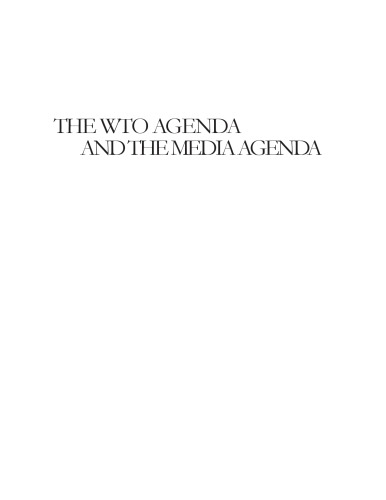

Most ebook files are in PDF format, so you can easily read them using various software such as Foxit Reader or directly on the Google Chrome browser.
Some ebook files are released by publishers in other formats such as .awz, .mobi, .epub, .fb2, etc. You may need to install specific software to read these formats on mobile/PC, such as Calibre.
Please read the tutorial at this link: https://ebookbell.com/faq
We offer FREE conversion to the popular formats you request; however, this may take some time. Therefore, right after payment, please email us, and we will try to provide the service as quickly as possible.
For some exceptional file formats or broken links (if any), please refrain from opening any disputes. Instead, email us first, and we will try to assist within a maximum of 6 hours.
EbookBell Team

4.8
34 reviews 
ISBN 10: 8791522102
Author: Rune Saugmann Andersen, Lasse Skjoldan
This book is based on a quantitative content analysis of the press coverage of the World Trade
Organisation (WTO) negotiations as it unfolded in 776 newspaper articles from Argentina, India, Spain, the UK, and the US during four Ministerial Conferences of the so-called ‘Doha Development Agenda’ (DDA) negotiations. While the DDA was set off in 2001 and was intended to be concluded by the end of 2004, the multilateral negotiations are in the end of 2007 still short of agreement. This thesis conceives of the media agenda as an important factor influencing trade policy formation and trade negotiation in the WTO. Combining elements from agenda-setting and institutional media theory, the study examines which issues and themes have been covered (priming) and from which angles these issue have been covered (framing). In particular, this thesis investigates the degree to which this priming and framing seems to be institutionalised across time (the four summits) and across space (the five countries). Using stable trends in coverage as indications of institutionalisation the thesis concludes that the press agendas are highly institutionalised across both time and space. This is so because: A) From mentioning several purpose-definitions of what the DDA talks are about, the press in both G20 and OECD countries has narrowed down its purpose-definitions to only two: liberalisation and development for the poor. B) In all countries, it is increasingly the same themes and issues, namely Breakdown or breakthrough and agriculture that dominate the press agendas. C) The most covered issues are in all countries framed with an increasing bias in favour of liberalisation. D) The poor are in all countries framed as the sole victims of a lack of liberalisation, and E) the rich are in all countries framed as the ones who should liberalise.
When this particular press coverage of the DDA is highly institutionalised, it means that it will be sticky and less prone to change. And because the media agenda is taken to affect the WTO agenda, the actors who are (dis)advantaged from this particular coverage in the press will likely continue to be so some time into the future.
the wto agenda and the media agenda
the wto was created
the wto members
the wto preceded the gatt
the wto was established to
the purpose of the wto conference and which organizations attended
the agenda of the wto is broader than the gatt
Tags: Rune Saugmann Andersen, Lasse Skjoldan, WTO, Agenda, Media, Villains, Victims, International, Press, Coverage, Doha, Development, Negotiations